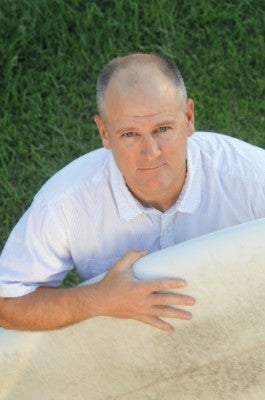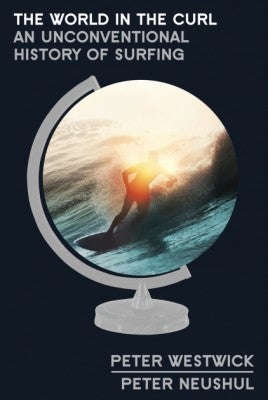A Historian Explores the Evolution of Surfing
Trojans weigh in on that most quintessential of Southern California sports: surfing.
The idea came to them, appropriately enough, while they were surfing, bobbing on the ocean and daydreaming about how to combine work and fun—the classic surfer’s dream.
Longtime friends, surfers and family men Peter Westwick and Peter Neushul also have a profession in common: historian. So, they thought, why not explore the past through surfing, the sport they love? Westwick, USC Dornsife assistant professor of history, and Neushul, researcher and lecturer in history at UC Santa Barbara, did just that, first through a class at UCSB and then through their 2013 book, The World in the Curl: An Unconventional History of Surfing. It’s considered, as one former pro surfer put it, “the most scholarly and comprehensive history of the sport.”
Here, Westwick discusses how surfing changed—and was changed by—shifting world tides.

Did you worry that your colleagues in academia would look down their noses at a project conceived on a surfboard?
We worried about that at first, that surf history would be seen as kind of dilettantism. And sometimes sports history in general is viewed that way, though that’s changing, thankfully. But when we approached [UCSB] about offering this class, they were all for it. And then we got this tremendous response and had to turn away hundreds of students. So obviously a lot of students wanted to learn about this stuff, and while they were there, we also taught them important history on serious subjects: colonialism, race and gender issues, the military-industrial complex, modern technology, commercialization, globalization.
Surfing’s birthplace is in Hawaii. Why?
If you go back and look at Hawaiian society and culture 400 or 500 years ago, what are the characteristics of it? Well, they are an amazing ocean people because they had to be amazing ocean people to get to the islands over thousands of miles of open sea. They are amazing swimmers, again the theme of swimming. And they had this amazingly developed system of food production, including fish farming, which gave them the leisure time that surfing requires.
We hear a lot nowadays about the decline of California, with the housing crash and industry leaving. Has that hurt surfing?
Well, it certainly affected the surf industry. People stopped buying everything, from surfboards to T-shirts, and the major [surf] firms took a huge hit in the recession. But this is not the first time the state has been through one of these dips. When California came back before, the surf community came back with it.
As historians, we want to explain why a particular event happened in this particular time and place, and not earlier or later, and not somewhere else. Why, then, did this Polynesian pastime become so identified with California? There are a number of reasons. One is the development of defense industry technologies. The invention of the wetsuit, for use by Navy frogmen, was huge for California. You hear stories about guys surfing in the winter back in the ’50s, pre-wetsuit, who’d go out for 10 minutes, catch one wave and then be back on the beach in front of a fire because they’d be hypothermic. Even in summertime, the water’s not that warm. So surfing in California would be tenuous without the wetsuit.
But then there’s also the demand, which comes from all these kids whose families have been lifted up into the middle class by that tremendous infusion of defense money. They are the ones who are then going out and buying surfboards, and they have the time and the money to go hang out on the beach. Surfing has been this leisure-time activity that depends on a certain amount of affluence in society.
The picture you portray in the book is not the idyllic “Surfin’ U.S.A.” Did you worry about creating a negative image of the sport?
We were very conscious that there were some myths out there in the surf literature that needed to be punctured. Maybe we’re not sufficiently—I’m trying to think of the right word here—reverent about surfing. We love surfing. We’ve been surfing for over 30 years, each one of us. We’re teaching our kids to surf. But we also think there are things in surfing’s past that need to be talked about, like issues of race, gender discrimination, even environmental activism, or the lack of it.
Everybody in the book seems to have a flaw or a downfall or a sad ending.
We weren’t consciously trying to write an antihero, critical book. We find many surfers to admire, starting with Duke Kahanamoku. As historians, though, we understand that people are complicated. Existing surf books have presented the heroic side. So in a sense we’re kind of a corrective for the promotion of heroic legends like Miki Dora. Dora, dubbed the king of Malibu, was infamous for painting a swastika on his surfboard. The guy was a fantastic surfer, but he was a bigot. He was charismatic and a lot of people loved him. But you have to call him out when he’s just spouting racist garbage.
You mention that other surfers were largely silent about Dora’s racism. What does that say about the surf community in general?
We don’t want to say that surfers are racist. Surfing came out of Hawaii and dark-skinned people were its originators. Later, there are instances of Hawaiians going to South Africa under apartheid, and the South African surfers sticking up for them. So we want to be careful about using a broad brush. But the fact remains if you go surfing in most lineups in California, it’s a lot of white faces. As historians, we step back and say, well, what are the reasons for that? Is it because surfers are racist, or is it because of socioeconomic reasons?
The history of swimming in America is a very interesting and complicated one that helps explain racial segregation in surfing. Originally, public pools were integrated racially, but they were gender segregated. When men and women were allowed to swim together, the pools became racially segregated because they didn’t want white women swimming with African American men. So then, African Americans are shunted off to Jim Crow pools which were not maintained, or not built to begin with. The upshot is, African Americans don’t learn how to swim. We have the statistics in the book which show that whites are twice as likely to know how to swim than African Americans. So untangling some of these other historical factors allows us to go beyond just saying that surfers are racist.
Who’s your personal hero of surfing?
I’d have to single out Duke. (Pro surfer and five-time Olympic medalist in swimming Duke Paoa Kahinu Mokoe Hulikohola Kahanamoku, 1890 – 1968.) Hawaiians talk about “aloha” and the sprit of giving. He really did have that and practiced that. People talk about Duke as being Kelly Slater and Michael Phelps rolled into one, a guy who was world-dominant in two separate sports, surfing and swimming. He was just a fantastic ambassador for both sports, and for Hawaiian culture in general. You see him sitting on the pool deck at the Olympics and playing his ukulele, charming everybody. He was not a businessman, maybe because he wasn’t selfish enough or self-driven enough. But it’s hard to find people who had a bad word to say about him.

How is the culture of surfing changing in California?
Beach communities up and down the California coast are generally Caucasian communities. And again, there are historical explanations for that, starting with real estate prices but also real estate red-lining. In places like Manhattan Beach, early African American residents were red-lined out of there. So these historical forces explain why certain cultural or ethnic groups prefer this or that sport. But in surfing, that is changing. The practice of red-lining went away mid-century and the demographics have been changing dramatically. Surf line-ups have reflected this in the recent decade. In Santa Barbara, where I surf, Bobby Martinez was one of the first Latino pro surfers to hit the scene and make a mark. So just looking around line-ups you start to see a little more ethnic and gender diversity.
At one time, people had high hopes for surfing to mature as a professional sport. Did it fall short of its ambitions?
Yes, and this connects to one of the really big themes of the book, which is this tension between two images of surfing. One is really a romantic view that goes back to its Hawaiian roots—the surfer as individual, out there alone in the elements, just you and nature, almost quasi-spiritual. The other is the modern version—the middle-class, mainstream, commercialized, professionalized sport using high technology. Surfing has always really wrestled with these competing images. Every time surfing starts becoming more mainstream and commercial, there’s a little bit of an undertow or backlash within the surfing community. It almost seems like there’s a built-in governor on how big surfing gets, because as soon as it starts to get more mainstream, surfers start pulling back.
Which image do you personally buy into: the romantic or the modern?
One of the occupational hazards of being a historian is cynicism. And so you see this romantic image and you think, OK, the surf industry is packaging this and selling it to the public to make money. But we had this experience while we were in Hawaii doing research. One evening, we just jump in the ocean right at Waikiki, the cradle of surfing, where all the old legends say ancient Hawaiians went surfing. We paddle out, warm waters, setting sun. We hear the ukulele music coming from the beach and we’re out there catching these fun little waves. And it was just this—I don’t want to say magical—but just a fantastic experience. And that reminded us why people still believe in this romantic image, because there is this grain of truth in it.
I still sense a little intellectual hesitation, like it’s hard for you to just say you were stoked out there.
Yeah, we were stoked! That’s a great way to put it. It was an amazing experience. It was a blast. We were out in the water high-fiving each other. That’s what it’s all about.
